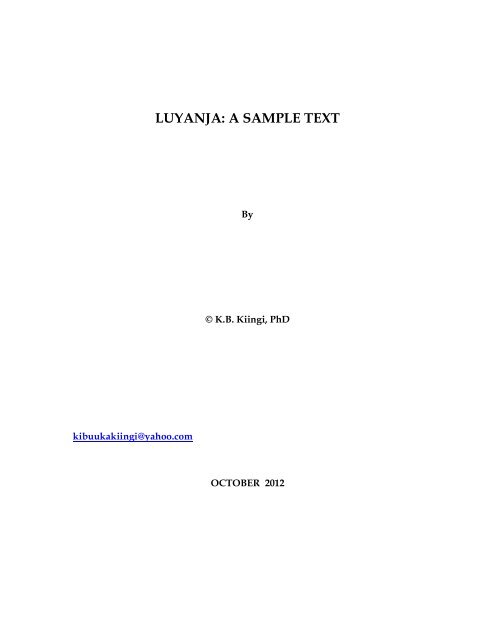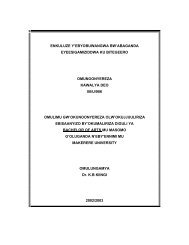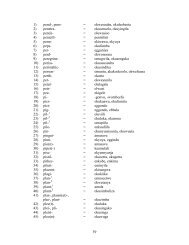luyanja_a_sample_text - Luganda Scientific Terminologies Research
luyanja_a_sample_text - Luganda Scientific Terminologies Research
luyanja_a_sample_text - Luganda Scientific Terminologies Research
Create successful ePaper yourself
Turn your PDF publications into a flip-book with our unique Google optimized e-Paper software.
kibuukakiingi@yahoo.com<br />
LUYANJA: A SAMPLE TEXT<br />
By<br />
© K.B. Kiingi, PhD<br />
OCTOBER 2012
LUYANJA: A SAMPLE TEXT<br />
It will be recalled that in the last two months I have posted two papers on<br />
Luyanja on this site. First, I heralded Luyanja under “Announcing the Emergence<br />
of Luyanja”. As a sequel to that I presented a list of circa 200 affixes of Luyanja<br />
under “A Reference List of Luyanja Affixes”. The purpose of the present paper is<br />
to afford the critically circumspect reader, especially the well scientifically<br />
tutored reader, a glimpse at Luyanja in actual use. The <strong>sample</strong> <strong>text</strong> is extracted<br />
from what normally counts as a basic university <strong>text</strong>book on physics or applied<br />
mathematics. A clarification is in order from the very outset: the rendition into<br />
Luyanja is intentionally left unannotated. Finally, if you are a scientist without a<br />
reading knowledge of <strong>Luganda</strong>, it will be virtually an uphill task to appreciate<br />
the import of the paper.<br />
Extract<br />
VECTORS, VELOCITY and ACCELERATION<br />
MECHANICS, KINEMATICS, DYNAMICS AND STATICS<br />
Mechanics is a branch of physics concerned with motion or change in position of<br />
physical objects. It is sometimes further subdivided into:<br />
(1) Kinematics, which is concerned with the geometry of the motion,<br />
(2) Dynamics, which is concerned with the physical causes of the<br />
motion,<br />
(3) Statics, which is concerned with conditions under which no motion<br />
is apparent.<br />
AXIOMATIC FOUNDATIONS OF MECHANICS<br />
An axiomatic development of mechanics, as for any science, should contain the<br />
following basic ingredients:<br />
(1) Undefined terms or concepts. This is clearly necessary since ultimately<br />
any definition must be based on something which remains<br />
undefined.<br />
(2) Unproved assertions. These are fundamental statements, usually in<br />
mathematical form, which it is hoped will lead to valid descriptions<br />
of phenomena under study. In general these statements, called<br />
axioms or postulates, are based on experimental observations or<br />
abstracted from them. In such case they are often called laws.<br />
(3) Defined terms or concepts. These definitions are given by using the<br />
undefined terms or concepts.<br />
(4) Proved assertions. These are often called theorems and are proved<br />
from the definitions and axioms.<br />
2
An example of the”axiomatic way of thinking” is provided by Euclidean geometry<br />
in which point and line are undefined concepts.<br />
MATHEMATICAL MODELS<br />
A mathematical description of physical phenomena is often simplified by<br />
replacing actual physical objects by suitable mathematical models. For example in<br />
describing the rotation of the earth about the sun we can for many practical<br />
purposes treat the earth and sun as points.<br />
SPACE, TIME AND MATTER<br />
From everyday experience, we all have some idea as to the meaning of each of<br />
the following terms or concepts. However, we would certainly find it difficult to<br />
formulate completely satisfactory definitions. We take them as undefined<br />
concepts.<br />
(1) Space. This is closely related to the concepts of point, position,<br />
direction and displacement. Measurement in space involves the<br />
concepts of length or distance, with which we assume familiarity.<br />
Units of length are feet, meters, miles, etc. In this book we assume<br />
that space is Euclidean, i.e. the space of Euclid’s geometry.<br />
(2) Time. This concept is derived from our experience of having one<br />
event taking place after, before or simultaneous with another event.<br />
Measurement of time is achieved, for example, by use of clocks.<br />
Units of time are seconds, hours, years, etc.<br />
(3) Matter. Physical objects are composed of “small bits of matter”<br />
such as atoms and molecules. From this we arrive at the concept of<br />
a material object called a particle which can be considered as<br />
occupying a point in space and perhaps moving as time goes by. A<br />
measure of “quantity of matter” associated with a particle is called<br />
mass. Units of mass are grams, kilograms etc. Unless otherwise<br />
stated we shall assume that the mass of a particle does not change<br />
with time.<br />
Length, mass and time are often called dimensions from which other physical<br />
quantities are constructed. For discussion of units and dimensions see Appendix<br />
A, Page 339.<br />
3
SCALARS AND VECTORS<br />
Various quantities of physics, such as length, mass and time, require for their<br />
specification a single real number (apart from units of measurement which are<br />
decided upon in advance). Such quantities are called scalars and the real number<br />
is called the magnitude of the quantity. A scalar is represented analytically by a<br />
letter such as t, m, etc.<br />
Other quantities of physics, such displacement require for their specification a<br />
direction as well as magnitude. Such quantities are called vectors. A vector is<br />
represented analytically by a bold faced letter such as A in Fig. 1-1.<br />
Geometrically it is represented by an arrow PQ where P is called the initial point<br />
and Q is called the terminal point. The magnitude or length of the vector is then<br />
denoted by |A| or A.<br />
Q<br />
A A<br />
B A<br />
P -A<br />
Kib. 1-1 Kib 1-2 Kib. 1-3<br />
VECTOR ALGEBRA<br />
The operations of addition, subtraction and multiplication familiar in the algebra<br />
of real numbers are with suitable definition capable of extension to an algebra of<br />
vectors. The following definitions are fundamental.<br />
(1) Two vectors A and B are equal if they have the same magnitude and<br />
direction regardless of their initial points. Thus A = B in<br />
Fig. 1-2 above.<br />
(2) A vector having direction opposite to that of vector A but with the<br />
same length is denoted by–A as in Fig. 1-3 above.<br />
(3) The sum or resultant of vectors A and B of Fig. 1-4(a) below is a<br />
vector C formed by placing the initial point of B on the terminal<br />
point of A and joining the initial point of A to the terminal point of<br />
B [see Fig. 1-4(b) below]. We write C = A + B. This definition is<br />
equivalent to the parallelogram law for vector addition as indicated<br />
in Fig. 1-4(c) below.<br />
4
B<br />
A B A<br />
A<br />
C = A + B C = A + B<br />
B<br />
(a) (b) (c)<br />
Kib 1 -4<br />
Extensions to sums of more than two vectors are immediate. For example, Fig. 1-<br />
5 below shows how to obtain the sum or resultant E of the vectors A, B, C and D.<br />
A B D B<br />
C<br />
Fig. 1-5<br />
5<br />
A<br />
C<br />
E = A +B + C + D<br />
(4) The difference of vectors A and B, represented by A - B, is that<br />
vector C which when added to B gives A. Equivalently, A - B may<br />
be defined as A + (-B). If A = B, then A - B is defined as the null or<br />
zero vector represented by 0. This has a magnitude of zero but its<br />
direction is not defined.<br />
(5) The product of a vector A by a scalar p is vector pA or Ap with<br />
magnitude |p| times the magnitude of A and direction the same as<br />
or opposite to that of A according as p is positive or negative. If p=<br />
0, pA= 0, the null vector.<br />
Translation into Luyanja<br />
Murray R, Spiegel (1967) Theoretical Mechanics, Chapter 1 pp<br />
1-3: Shaum‘s Outline Series, Mc-Grain Book Company<br />
D
ZIVEKTA, OMUSONGAWILO, NE OMWANGUWILO<br />
MEKANIKA, KINEMATIKA, DYUNAMIKA NE STATIKA<br />
Mekanika ttabi lya fyusika elyekuusa ku kusonga oba okukyuka<br />
ekyeteeko/ekyesangilo kya emibili emifyusikafa. Mekanika oluusi<br />
agabawansibwamu:<br />
(1) Kinematika, eyekuusa ku wapimansi wa okusonga,<br />
(2) Dyunamika, eyekuusa ku ebileetela ebufyusikafa bya okusonga,<br />
(3) Statika, eyekuusa ku mbeela omutayolekelwa kusonga.<br />
EMISINGI EMIAXIOMAFA GYA MEKANIKA<br />
Okwanjuluza mekanika ekiaxioma, nga ela bwe kiba kulwa wakumanya omulala<br />
yenna, kwandisaanidde kubeleemu ebigendamilasinga bino:<br />
(1) Ebimiimo oba ebikwatawamo ebitasonjole. Kino awatali kuwannaanya<br />
kikaka kubanga mu buli ngeli buli kisonjolo kyonna kiteekwa<br />
okwesigamizibwa ku kintu ekisigala nga si kisonjole.<br />
(2) Ebikazo ebitakakase. Bino bitegeezasingo, nga bitela kuba mu kikula<br />
kimathematikafa, nga kisuubilwa nti binatuusa ku nzitottolo za<br />
ebyeyolesa ebiyitibwa axioma oba ebisabo, byesigamizibwa ku<br />
bikengo ebigezesafa oba binogolwako. Bwe kiba bwe kityo bitela<br />
okuyitibwa amateeka.<br />
(3) Ebimiimo oba ebikwatawamo ebisonjole. Ebisonjolo bino biweelebwa<br />
mu kukozesa ebimiimo oba ebikwatawamo ebitasonjole.<br />
(4) Ebikazo ebikakase. Bino bitela kuyitibwa biwandabo ela bikakasibwa<br />
kuva mu bisonjolo ne axioma.<br />
Ekyokulabisisa “endowooza ya ekiaxioma“ kiweebwa wapimansi owa ekiEuclid<br />
omuli akafunitilo ne oluteleevu nga ebikwatawamo ebitasonjole.<br />
EBIGEEGEENYO EBIMATHEMATIKAFA<br />
Ekittottolo ekimathematikafa ekya ebyeyoleso ebibilifa kitela okuwewulwa nga<br />
ebikuuli byennyini ebifyusikafa biwaanyisibwa na ebyigeegeenyo ebimathematikafa.<br />
Okugeza, mu kuttottola okwekulungulila kwa nnattaka ku njuba tuyinza<br />
okutwala nnattaka ne enjuba nga otufumitilo mu nkola eya bulijjo.<br />
6
EBBANGA, EKISEELA NE MATERIA<br />
Okuva mu bumanyilivu obwa bulijjo ffenna tulina ekitegeelo kya makulu ga buli<br />
ku bimiimo oba ebikwatawano ebiddilila. Kyokka, ddala twandilemelelwa<br />
okwasanguzaddala ebisonjolo ebimatiza. Tubitwala nga ebikwatawamo<br />
ebitasonjole.<br />
(1) Ebbanga. Lino ligandanila ddala ne ebikwatawamo bya akafumitilo ,<br />
akateekelo, oluyolekelo ne oluseetuko. Okupimila mu bbanga<br />
kuzingilamu ebikwatawamo bya obuwanvu oba olwesuulo, bye<br />
tutwala nga bimanyiddwa. Eminwe gya obuwanvu ze ffuuti,<br />
metra, mailo, nll. Mu kitabo kino ebbanga tulitwala okuba elya<br />
ekiEuclid, k.k. ebbanga lya wapimansi wa Euclid.<br />
(2) Ekiseela. Ekikwatawamo kino kiviisibwa mu bumanyilivu bwaffe<br />
mu kuba ne ekituuko okubeelawo oluvannyuma, mu maaso oba mu<br />
kiseela kye kimu ne ekituuko ekilala. Okupima ekiseela tukozesa<br />
ssaawa, nga ekyokulabilako. Eminwe gya ekiseela ze sikonda,<br />
ssaawa, myaka, nll.<br />
(3) Materia. Ebikuuli ebifyusikafa bibaamu “otukunkumuka twa<br />
materia“ nga atoma ne otumola. Okuva wano tutuuka ku<br />
kikwatawamo kya ekikuuli ekimateriafa ekiyitibwa akasilikitu<br />
aksaobola okulowoozebwako nga katwala kafumitilo mu bbanga<br />
ela nga kaseguka nga ne ekiseela bwe kigenda.<br />
Ekipimo kya “obungi bwa materia“ ekinywanyibwa ne akasilikitu kiyitibwa<br />
omutole gwako. Eminwe gya omutole ze grama, kilograma, nll. Okuggyako nga<br />
kitegeezebbwa tujja kukitwala nti omutole gwa akasilikitu tegukyuka na kiseela.<br />
Obuwanvu , omutole ne ekiseela bitela okuyitibwa empimo ebingi ebifyusikafu<br />
ebilala mwe biviisibwa. Olwa ekinyeenyawuno ku minwe ne empimo laba<br />
Enkookelo A, Oluuyi 339.<br />
EBIDAALAFA NE VEKTA<br />
Ebingi ebyawufu bya fyusika, okugeza obuwanvu, omutole ne ekiseela<br />
byetaagisa ennamba wawu emu okubyatuukiliza (okuggyako eminwe gya<br />
okupima egikkaanyizibwako ku ntandikwa). Ebingi bwe bityo biyitibwa bidaalafa<br />
ela ennamba wawu eyitibwa obwaguuga bwa ekingi. Kiyunguluzi, ekidaalafa<br />
kibakilwa na nnukuta nga , t, m , nll.<br />
Ebingi bya fyusika ebilala, okugeza oluseetuko, byetaagisa luyolekelo ne<br />
obwaguuga okwatuukilizibwa. Ebingi bwe bityo biyitibwa vekta. Kiyunguluzi ,<br />
7
vekta ebakilwa na nnukuta entwakaavu nga A mu Kib ∗ 1.1. Kipimansi ebikilwa<br />
na kasaale PQ nga P eyitibwa akafumitilo akasooka ate nga Q eyitibwa akafumitilo<br />
kakoobela. Obwaguuga oba obuwanvu bwa vekta bulambibwa na |A| oba A.<br />
Q<br />
A A<br />
B A<br />
P -A<br />
Kib. 1-1 Kib 1-2 Kib. 1-3<br />
ALGEBRAAVEKTA<br />
Ebikolebwa bya okugatta, okutoola ne okubaza ebimanyiddwa ennyo mu<br />
algebra wa ennamba wawu bisobola okugaziyizibwa okutuuka ku algebra wa<br />
vekta nga ensojola esaanidde ekozesebbwa. Ebisonjolo wammanga bya ku<br />
musingi.<br />
∗ Kib. = Kibaka<br />
(1) Vekta bbili A ne B zenkana singa ziba ne obwaguuga ne oluyolekelo<br />
bye bimu awatali kufa ku tufumitilo twazo otusooka. Noolwekyo<br />
A = B mu Kib. 1-2 waggulu<br />
(2) Vekta elina oluyolekelo olukontana ne olwo olwa vekta A naye nga<br />
elina obuwanvu bwe bumu elambibwa na –A nga mu Kib. 1-3<br />
waggulu.<br />
(3) Omugatto oba omuviiso gwa vekta A ne B eza Kib.1-4(a) wammanga<br />
ye vekta C ezimbibbwa nga akafumitilo akasooka aka B<br />
kateekebwa ku kafumitilo akakoobela ka A ela nga akafumitilo<br />
akasooka ka A kayungibwa ku kafumitilo akakoobela ka B ( laba<br />
Kib. 1-4(b) wammanga) Tuwandiika C= A + B. Ekisonjolo kino<br />
kiwendonkana etteeka lya ollundiikasegalala olwa okugatta vekta nga<br />
bwe kilagiddwa mu Kib. 1-4(c) wammanga.<br />
8
B<br />
A B A<br />
A<br />
C = A + B C = A + B<br />
B<br />
(a) (b) (c)<br />
Kib 1 -4<br />
Engaziyo ezituuka ku migatto gya vekta ezisukka mu bbili<br />
ntakatika. Okugeza, Kib.1-5 wammanga, kilaga enfuna ya<br />
omugatto oba omuviiso E ogwa vekta A, B , C ne D.<br />
A B D B<br />
C<br />
Kib. 1-5<br />
9<br />
A<br />
C<br />
E = A +B + C + D<br />
(4) Enjawulo ya vekta A ne B, ebakilwa A - B, ye vekta C nga bwe<br />
gattibwa ku B ewa A. Kiwendonkana, A - B esonjolekeka nga<br />
A +( -B).<br />
Singa A = B, olwo A - B esonjolebwa nga vekta zero ebakilwa 0.<br />
Eno elina obwaguuga bwa zero naye oluyolekelo telusonjolwa.<br />
(5) Omuzaalo gwa vekta A ne ekidaalafa p ye vekta pA oba Ap ne<br />
obwaguuga emilundi |p| obwaguuga bwa A ne oluyolekelo bye<br />
bimu oba ebikontana ne ogwo ogwa A okusinziila ku p nga mpazi<br />
oba nga nnghaanyi. Singa p= 0, pA= 0, vekta zero.<br />
D
To conclude this paper, let the clichéd question “Now, what is the way<br />
forward?” be responded to. While the process of exemplifying Luyanja will<br />
assuredly continue, two salient tasks present themselves to us. First, a<br />
comprehensive reference grammar of Luyanja is in need of codification. Second,<br />
we shall undertake compilation of English-Luyanja dictionaries for the basic<br />
sciences of logic, mathematics, physics, chemistry, biology and economics.<br />
But the rate of parallel accomplishment of the tasks will be determined by<br />
availability of research funding.<br />
10





